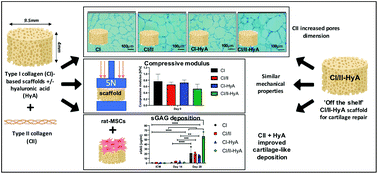A highly porous type II collagen containing scaffold for the treatment of cartilage defects enhances MSC chondrogenesis and early cartilaginous matrix deposition
Abstract
A major challenge in cartilage tissue engineering (TE) is the development of instructive and biomimetic scaffolds capable of driving effective mesenchymal stem cell (MSC) chondrogenic differentiation and robust de novo matrix formation. Type I collagen-based scaffolds are one of the most commonly selected materials given collagen's intrinsic ability to act as an instructive and active biomaterial. However, the chondrogenic potential of these scaffolds does not offer significant improvement over traditional treatments. We propose that taking a biomimetic approach to scaffold development might lead to an improved outcome for enhanced cartilage repair. Therefore, this study aimed to develop innovative type II collagen (CII)-containing scaffolds for enhanced cartilage repair, by incorporating CII and/or hyaluronic acid (HyA) into a type I collagen (CI) framework. Moreover, focus was placed on understanding the potential synergistic effects played by CII in combination with HyA, in terms of MSC chondrogenesis and cartilage-like formation, when both molecules are incorporated into scaffold biomaterials. The newly developed CII-containing scaffold exhibited a highly porous interconnected structure with 99% porosity and similar mechanical properties to previously optimised collagen-based scaffolds. Although all scaffold variants sustained early cartilaginous matrix deposition, the CII-containing scaffolds in the presence of HyA performed best, offering enhanced deposition and distribution of sulphated glycosaminoglycans (sGAG) in vitro by day 28. Taken together, the combination of CII and HyA resulted in the development of a biomimetic scaffold with improved chondrogenic benefits. These simple “off-the-shelf” implants hold great promise to direct enhanced tissue regeneration for the treatment of focal cartilage defects.



 Please wait while we load your content...
Please wait while we load your content...